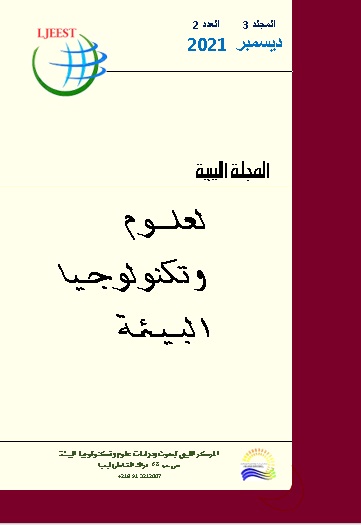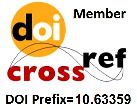الآثار العلاجية لفيتامين ج على سمية الاكرييلاميد في جرذان الألبينو على بعض المتغيرات المناعية
DOI:
https://doi.org/10.63359/dh7wdg42الكلمات المفتاحية:
الاكرييلاميد، المتغيرات المناعية، الجردان، فيتامين جالملخص
مادة الأكريلاميد (ACR) هي مادة كيميائية صناعية واسعة الانتشار لها آثار ضارة معروفة ليس فقط على البشر ولكن على الكائنات الحية الأخرى في البيئة أيضًا ، وتتشكل مادة الأكريلاميد أثناء تسخين الأطعمة النشوية عند درجة حرارة عالية ، وتعتبر مادة عالية السمية ومسرطنة للجينات. ونظرا لأهمية تأثير هذه المادة في جميع أنحاء العالم بشأن التسرطن من الاكريلاميد أصبحت كيفية الحد من سميتها موضوع بحث جدير بالدراسة . في هذه الدراسة تم تقسيم الجرذان البيضاء إلى ثلاث مجموعات. المجموعة الضابطة ومجموعة الجرذان المعالجة بالأكريلاميد والجرذان المعالجة بالأكريلاميد وفيتامين ج , أظهرت النتائج أن هناك تغيرات معنوية لوحظت في المؤشرات المناعية , حيث لم يكن هناك انخفاض معنوي (P> 0.05) في مـــــستوى TNF-α في الجرذان المعالجة بالأكريلاميد ،بينما كانت هناك زيادة معنوية في مستوى TNF-α في الجرذان المعالجة بالأكريلاميد المعــــالج بفيتامين ج. وكان هناك انخــــفاض معنـــوي (P <0.0001) في مستــــوى IL-17 للجرذان المعــــالجة بالأكريلاميد ، وكان هنـــاك انخــــفاض معنوي (P <0.05) في مستوى IL-17 في الجرذان المعالجة بالأكريلاميد و المعالجة بفيتامين ج بالمقارنة مع المجموعة الضابطة ، وهنا أثبتت الدراسة أن فيتامين ج أظهر تأثيرا واضحا للحماية من السمية التي يسببها الأكريلاميد.
المراجع
Acaroz U, Ince S, Arslan-Acaroz D, Gurler Z, Kucukkurt I, Demirel HH, Arslan HO, Varol N, Zhu K. The ameliorative effects of boron against acrylamideinduced oxidative stress, inflammatory response, and metabolic changes in rats. Food Chem Toxicol. 2018;118:745–52.
Affordofe Q, Reginald M. Toxic metal exposure and symptoms of respiratory infection among children (under-five) residing near open dumpsite: a cross-sectional study at Abokob, 2021, College of Health Sciences.
Ana Paula Konzen Riffel, Jéssica Araújo de Souza, Maria do Carmo Quevedo Santos, Adarly Kroth, Elza Maria Santos da Silveira and Taina Scheid. Co-administration of ascorbic acid and [alpha]-tocopherol modifies ascorbic acid and attenuates p38, Akt, and TNF-[alpha] expression in spinal cord of rats with neuropathic pain. Nutrire (2020) 45:9 https://doi.org/10.1186/s41110-019-0113-6.
Anese M, Quarta B, Frias J. Modelling the effect of asparaginase in reducing acrylamide formation in biscuits. Food Chem. (2011) 126:435–40. doi: 10.1016/j.foodchem.2010.11.007.
Anitra C. Carr, Shaw GM, Fowler AA, Natarajan R. Ascorbate-dependent vasopressor synthesis: a rationale for vitamin C administration in severe sepsis and septic shock. Crit Care. 2015; 19(1): 1– 8.
Bartkiene E, Jakobsone I, Juodeikiene G, Vidmantiene D, Pugajeva I, Bartkevics V. Study on the reduction of acrylamide in mixed rye bread by fermentation with bacteriocin-like inhibitory substances producing lactic acid bacteria in combination with Aspergillus niger glucoamylase. Food Control. (2013) 30:35–40. doi: 10.1016/j.foodcont.2012.07.012.
Chen W, Shen Y, Su H, Zheng X. Hispidin derived from Phellinus linteus affords protection against acrylamide-induced oxidative stress in Caco-2 cells. Chem Biol Interact. (2014) 219:83–9. doi: 10.1016/j.cbi.2014.05.010.
Chen W, Su H, Xu Y, Bao T, Zheng X. Protective effect of wild raspberry (Rubus hirsutus Thunb.) extract against acrylamide-induced oxidative damage is potentiated after simulated gastrointestinal digestion. Food Chem. (2016) 196:943–52. doi: 10.1016/j.foodchem.2015.10.024.
Dutta MK, Singh A, Ghosal S. A computer vision based technique for identification of acrylamide in potato chips. Comp Electron Agri. (2015) 119:40–50. doi: 10.1016/j.compag.2015.10.007.
-Elham N, Marzieh K, Abdorreza M, Abdolmohammad A. Acrylamide in bread samples: Determining using ultrasonic-assisted extraction and microextraction method followed by gas chromatography-mass spectrometry. Journal of Cereal Science, Volume 79, January 2018, Pages 1-5
Forstova V, Belkova B, Riddellova K, Vaclavik L, Prihoda J, Hajslova J. Acrylamide formation in traditional Czech leavened wheat-rye breads and wheat rolls. Food Contr. (2014) 38:221–6. doi: 10.1016/j.foodcont.2013.10.022.
Gann PH. Randomized trials of antioxidant supplementation for cancer prevention: first bias, now chance--next, cause. Jama. 2009; 301:102–103.
Hagmar L, Törnqvist M, Nordander C, Rosén I, Bruze M, Kautiainen A, et al. Health effects of occupational exposure to acrylamide using hemoglobin adducts as biomarkers of internal dose. Scand J Work Environ Health. (2001) 27:219–26. doi: 10.5271/sjweh.608.
Imen Ghorbel ,Sameh Maktouf, Choumous Kallel, Semia Ellouze Chaabouni, Tahia Boudawara, Najiba Zeghal. Disruption of erythrocyte antioxidant defense system, hematological parameters, induction of pro-inflammatory cytokines and DNA damage in liver of co-exposed rats to aluminium and acrylamide. Chemico-Biological Interactions, Volume 236, 5 July 2015, Pages 31-40, https://doi.org/10.1016/j.cbi.2015.04.020.
Ji Hyun Lee, Yoon-Jae Jeon, Jung Hye Choi, Hae Young Kim and Tae-Yoon Kim. Effects of VitabridC12 on Skin Inflammation. 2017, The Korean Dermatological Association and The Korean Society for Investigative Dermatology, Ann Dermatol. 2017 Oct ; 29(5):548-558. https://doi.org/10.5021/ad.2017.29.5.548
Jie Guo, Xiaolu Cao , Xianmin Hu, Shulan Li, and Jun Wang. The anti-apoptotic, antioxidant and antiinflammatory effects of curcumin on acrylamide-induced neurotoxicity in rats. Guo et al. BMC Pharmacology and Toxicology (2020) 21:62 10.1186/s40360-020-00440-3.
Long CL, Maull KI, Krishnan RS, Laws HL, Geiger JW, Borghesi L, et al. Ascorbic acid dynamics in the seriously ill and injured. J Surg Res. 2003; 109: 144– 148.
Marquez G, Anon M. Influence of reducing sugars and amino acids in the color development of fried potatoes. J Food Sci. (1986) 51:157–60. doi: 10.1111/j.1365-2621.1986.tb10859.
Mi Hye Song , Varun Sasidharan Nair, Kwon Ik Oh.Vitamin C enhances the expression of IL17 in a Jmjd2-dependent manner.2017Jan;50(1):49-54 bmbrep.2017.50.1.193.PMCID: PMC5319665,DOI: 10.5483/bmbrep.2017.50.1.193
Parzefall W. Minireview on the toxicity of dietary acrylamide. Food Chem Toxicol. (2008) 46:1360–4. doi: 10.1016/j.fct.2007.08.027.
Rawi SM, Marie MAS, Fahmy SR, El-Abied SA. Hazardous effects of acrylamide on immature male and female rats. Afr J Pharm Pharmacol 2012; 6(18): 1367-86.
Santhanasabapathy R, Vasudevan S, Anupriya K, Pabitha R, Sudhandiran G. Farnesol quells oxidative stress, reactive gliosis and inflammation during acrylamide-induced neurotoxicity: behavioral and biochemical evidence. Neuroscience. 2015;308:212–27.
Seyed Mohammad Seifati, Erfan Zaker, Farzaneh Fesahat. Modulatory Effect of Probiotics on Proinflammatory Cytokine Levels in Acrylamide-Treated Rats, 2021, Biochemistry Research International , Volume 2021, Article ID 2268770 , doi.org/ 10.1155/2021/2268770.
Soliman, Ghada ZA. "Protective Effect of Solanum nigrum, Vitamin C or Melatonin on the Toxic Effect of Acrylamide on Rats."2019, IOSR Journal of Pharmacy and Biological Sciences (IOSR-JPBS) e-ISSN: 2278-3008. Volume 5, Issue 5 (Mar. – Apr. 2013), PP 47-54. w.ww.iosrjournals.org.
Soma P, Bapi G, Santwana P, Hira C, Gamal A., Shadab Md, Dinesh M. Recent update of toxicity aspects of nanoparticulate systems for drug delivery, European Journal of Pharmaceutics and Biopharmaceutics. Volume 161, April 2021, Pages 100-119.
Spencer PS, Schaumburg HH. A review of acrylamide neurotoxicity Part I. Canad J Neurol Sci. (1974) 1:143–50. doi: 10.1017/S0317167100019739.
التنزيلات
منشور
إصدار
القسم
الرخصة
الحقوق الفكرية (c) 2025 المجلة الليبية لعلوم وتكنولوجيا البيئة (LJEEST)

هذا العمل مرخص بموجب Creative Commons Attribution-NonCommercial 4.0 International License.











